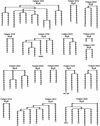Phylogenetic and familial estimates of mitochondrial substitution rates: study of control region mutations in deep-rooting pedigrees
- PMID: 11582570
- PMCID: PMC1274355
- DOI: 10.1086/324024
Phylogenetic and familial estimates of mitochondrial substitution rates: study of control region mutations in deep-rooting pedigrees
Abstract
We studied mutations in the mtDNA control region (CR) using deep-rooting French-Canadian pedigrees. In 508 maternal transmissions, we observed four substitutions (0.0079 per generation per 673 bp, 95% CI 0.0023-0.186). Combined with other familial studies, our results add up to 18 substitutions in 1,729 transmissions (0.0104), confirming earlier findings of much greater mutation rates in families than those based on phylogenetic comparisons. Only 12 of these mutations occurred at independent sites, whereas three positions mutated twice each, suggesting that pedigree studies preferentially reveal a fraction of highly mutable sites. Fitting the data through use of a nonuniform rate model predicts the presence of 40 (95% CI 27-54) such fast sites in the whole CR, characterized by the mutation rate of 274 per site per million generations (95% CI 138-410). The corresponding values for hypervariable regions I (HVI; 1,729 transmissions) and II (HVII; 1,956 transmissions), are 19 and 22 fast sites, with rates of 224 and 274, respectively. Because of the high probability of recurrent mutations, such sites are expected to be of no or little informativity for the evaluation of mutational distances at the phylogenetic time scale. The analysis of substitution density in the alignment of 973 HVI and 650 HVII unrelated European sequences reveals that the bulk of the sites mutate at relatively moderate and slow rates. Assuming a star-like phylogeny and an average time depth of 250 generations, we estimate the rates for HVI and HVII at 23 and 24 for the moderate sites and 1.3 and 1.0 for the slow sites. The fast, moderate, and slow sites, at the ratio of 1:2:13, respectively, describe the mutation-rate heterogeneity in the CR. Our results reconcile the controversial rate estimates in the phylogenetic and familial studies; the fast sites prevail in the latter, whereas the slow and moderate sites dominate the phylogenetic-rate estimations.
Figures



Similar articles
-
High mitochondrial mutation rates estimated from deep-rooting Costa Rican pedigrees.Am J Phys Anthropol. 2012 Jul;148(3):327-33. doi: 10.1002/ajpa.22052. Epub 2012 Mar 28. Am J Phys Anthropol. 2012. PMID: 22460349 Free PMC article.
-
The mutation rate in the human mtDNA control region.Am J Hum Genet. 2000 May;66(5):1599-609. doi: 10.1086/302902. Epub 2000 Apr 7. Am J Hum Genet. 2000. PMID: 10756141 Free PMC article.
-
mtDNA hypervariable region II (HVII) sequences in human evolution studies.Eur J Hum Genet. 2000 Dec;8(12):964-74. doi: 10.1038/sj.ejhg.5200563. Eur J Hum Genet. 2000. PMID: 11175285
-
Hypervariable sites in the mtDNA control region are mutational hotspots.Am J Hum Genet. 2000 Oct;67(4):1029-32. doi: 10.1086/303092. Epub 2000 Aug 30. Am J Hum Genet. 2000. PMID: 10968778 Free PMC article.
-
Understanding differences between phylogenetic and pedigree-derived mtDNA mutation rate: a model using families from the Azores Islands (Portugal).Mol Biol Evol. 2005 Jun;22(6):1490-505. doi: 10.1093/molbev/msi141. Epub 2005 Apr 6. Mol Biol Evol. 2005. PMID: 15814829
Cited by
-
On the evolutionary mutation rate at Y-chromosome STRs: comments on paper by Di Giacomo et al. (2004).Hum Genet. 2005 May;116(6):529-32. doi: 10.1007/s00439-005-1281-4. Epub 2005 Mar 17. Hum Genet. 2005. PMID: 15772851 No abstract available.
-
The effective mutation rate at Y chromosome short tandem repeats, with application to human population-divergence time.Am J Hum Genet. 2004 Jan;74(1):50-61. doi: 10.1086/380911. Epub 2003 Dec 19. Am J Hum Genet. 2004. PMID: 14691732 Free PMC article.
-
Y-chromosome evidence for differing ancient demographic histories in the Americas.Am J Hum Genet. 2003 Sep;73(3):524-39. doi: 10.1086/377588. Epub 2003 Jul 28. Am J Hum Genet. 2003. PMID: 12900798 Free PMC article.
-
Distribution patterns of postmortem damage in human mitochondrial DNA.Am J Hum Genet. 2003 Jan;72(1):32-47. doi: 10.1086/345378. Epub 2002 Dec 12. Am J Hum Genet. 2003. PMID: 12489041 Free PMC article.
-
High mitochondrial mutation rates estimated from deep-rooting Costa Rican pedigrees.Am J Phys Anthropol. 2012 Jul;148(3):327-33. doi: 10.1002/ajpa.22052. Epub 2012 Mar 28. Am J Phys Anthropol. 2012. PMID: 22460349 Free PMC article.
References
Electronic-Database Information
-
- HVRbase, http://db.eva.mpg.de/hvrbase
References
-
- Anderson S, Bankier AT, Barrell BG, de Bruijn MH, Coulson AR, Drouin J, Eperon IC, Nierlich DP, Roe BA, Sanger F, Schreier PH, Smith AJ, Staden R, Young IG (1981) Sequence and organization of the human mitochondrial genome. Nature 290:457–465 - PubMed
-
- Baasner A, Schafer C, Junge A, Madea B (1998) Polymorphic sites in human mitochondrial DNA control region sequences: population data and maternal inheritance. Forensic Sci Int 98:169–178 - PubMed
-
- Batzer MA, Deininger PL (1991) A human-specific subfamily of Alu sequences. Genomics 9:481–487 - PubMed
MeSH terms
Substances
LinkOut - more resources
Full Text Sources
Other Literature Sources

